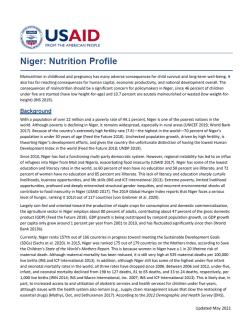With a population of over 22 million and a poverty rate of 44.1 percent, Niger is one of the poorest nations in the world. Although poverty is declining in Niger, it remains widespread, especially in rural areas (UNICEF 2019; World Bank 2017). Because of the country’s extremely high fertility rate (7.8)—the highest in the world—70 percent of Niger’s population is under 30 years of age (Feed the Future 2018). Unchecked population growth, driven by high fertility, is thwarting Niger’s development efforts, and gives the country the unfortunate distinction of having the lowest Human Development Index in the world (Feed the Future 2018; UNDP 2019).
Since 2010, Niger has had a functioning multi‐party democratic system. However, regional instability has led to an influx of refugees into Niger from Mali and Nigeria, exacerbating food insecurity (USAID 2017). Niger has some of the lowest education and literacy rates in the world, as 60 percent of men have no education and 58 percent are illiterate, and 72 percent of women have no education and 85 percent are illiterate. This lack of literacy and education sharply curtails livelihoods, business opportunities, and life skills (INS and ICF International 2013). Extreme poverty, limited livelihood opportunities, profound and deeply entrenched structural gender inequities, and recurrent environmental shocks all contribute to food insecurity in Niger (USAID 2017). The 2019 Global Hunger Index reports that Niger faces a serious level of hunger, ranking it 101st out of 117 countries (von Grebmer et al. 2020).
Largely rain‐fed and oriented toward the production of staple crops for consumption and domestic commercialization, the agriculture sector in Niger employs about 80 percent of adults, contributing about 47 percent of the gross domestic product (GDP) (Feed the Future 2018). GDP growth is being outstripped by rampant population growth, so GDP growth per capita only grew around 1 percent per year from 2001 to 2010, and has fluctuated significantly since then (World Bank 2013b).
Currently, Niger ranks 157th out of 166 countries in progress toward meeting the Sustainable Development Goals (SDGs) (Sachs et al. 2020). In 2015, Niger was ranked 175 out of 179 countries on the Mothers Index, according to Save the Children’s State of the World’s Mothers Report. This is because women in Niger have a 1 in 20 lifetime risk of maternal death. Although maternal mortality has been reduced, it is still very high at 535 maternal deaths per 100,000 live births (INS and ICF International 2013). In addition, although Niger still has some of the highest under‐five infant and neonatal mortality rates in the world, all three rates have dropped since 2006. Between 2006 and 2012, under‐five, infant, and neonatal mortality declined from 198 to 127 deaths, 81 to 65 deaths, and 33 to 24 deaths, respectively, per 1,000 live births (IRIN 2014; INS and Macro International, Inc. 2007; INS and ICF International 2013). This is likely due, in part, to increased access to and utilization of obstetric services and health services for children under five years, although issues with the health system also remain (e.g., supply chain management issues that slow the restocking of essential drugs) (Mathys, Oot, and Sethuraman 2017). According to the 2012 Demographic and Health Survey (DHS), the leading causes of child mortality are malaria (27 percent), cough and cold (19 percent), pneumonia (11 percent), and diarrhea (10 percent), with malnutrition most likely a large underlying contributor (INS and ICF International 2013).

